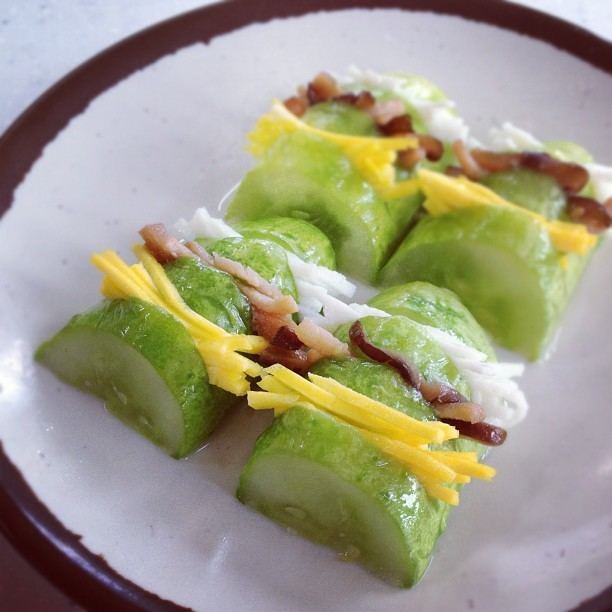Hangul 선 Revised Romanization Seon | Hanja 膳 McCune–Reischauer Son | |
 | ||
Seon is the name of a traditional Korean dish which is made with steamed vegetables such as zucchini, cucumber, eggplant, or Napa cabbages which are then stuffed with fillings. Although the term is a counterpart of jjim (a category of dishes that are made by steaming meat or seafood) the concept is not clearly settled.
Contents
Besides the dish, gajiseon (가지선, steamed eggplant), gochuseon (고추선, steamed chili pepper), donggwaseon (동과선, steamed winter melon), museon (무선, steamed radish), baechuseon (steamed napa cabbage) and dubuseon (steamed tofu) are also representatives of seon dishes.
Preparation
To make a hobakseon (호박선) or oiseon (오이선) - a zucchini or cucumber is cut into pieces about 4 or 5 cm. in length and then quartered. The pieces are briefly salted and then lightly squeezed to drain water from them. Beef or chicken, along with onions, are chopped and mixed with seasonings to make the filling. The prepared pieces of the zucchini or cucumber are stuffed with the filling and placed in a pot. Seasoned stock or vegetable broth is poured over the ingredients until they are soaked and either boiled or steamed for about 5 to 10 minutes. After the cooking is finished, slices of seogi (석이, Umbilicaria esculenta), chili peppers, and jidan (지단, fried eggs separated into white and yellow layers) are placed on the dish as gomyeong (고명, garnishes).
In historical cookbooks
According to a cookbook titled Eumsik dimibang that was written during the mid-Joseon Dynasty, the historic recipe of donggwaseon (동과선, a variety of seon dishes made with dongga (winter melon)) is very different from the modern one. Thick slices of a winter melon are lightly parboiled in water and then put into a bowl of the boiled mixture of ganjang with water and oil. The contents are then discarded and a new bowl of boiled ganjang is mixed with minced ginger and poured over the vegetables. Donggwaseon is preserved and is eaten with vinegar spread over it.
In Siui jeonseo, a cookbook written in the late 19th century, a recipe of hobakseon (호박선, zucchini seon) is similar to the modern seon dishes. A zucchini is hollowed out and filled with various condiments and then steamed. A sauce made with vinegar, ganjang and honey is poured over the cooked dish. Then sliced chili pepper, seogi (석이 Umbilicaria esculenta), and jidan (fried eggs) are placed on the zucchini with ground pine nuts on top.
However, the term did not have its modern meaning until as late as the 1930s. Cookbooks are written before that time use the term very differently. They refer to cheongeoseon (청어선, steamed herring with filling), yangseon (양선, steamed and stuffed beef intestine), or dalgyalseon (달걀선, steamed eggs).
At the present time, the term is limited to stuffed vegetable dishes.
